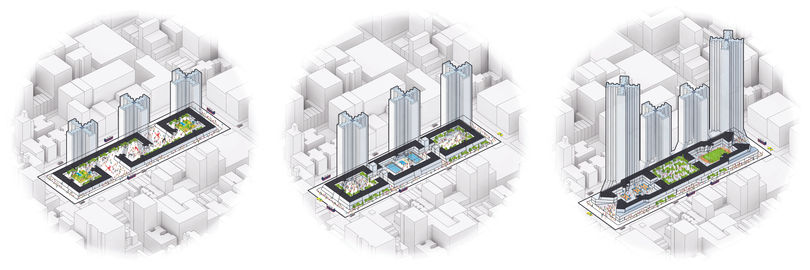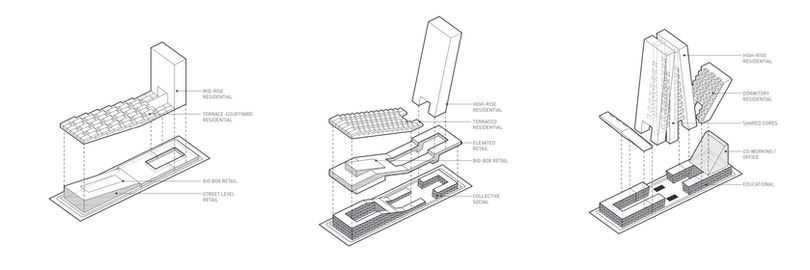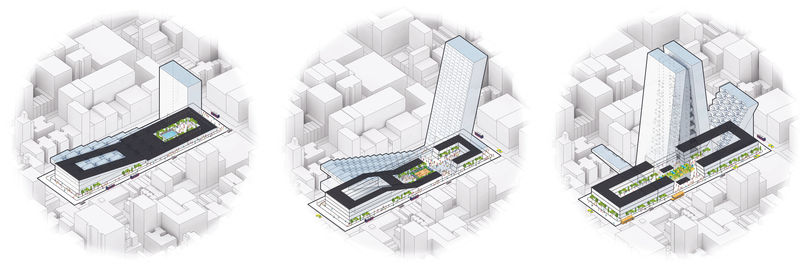![IMG-4858 [WHITE2].jpg](https://static.wixstatic.com/media/ce3a71_b4a0c8658f4446939c5b9f6a4d3a3726~mv2.jpg/v1/fill/w_573,h_430,al_c,q_80,usm_0.66_1.00_0.01,enc_avif,quality_auto/ce3a71_b4a0c8658f4446939c5b9f6a4d3a3726~mv2.jpg)
Throughout the last 200 years, the strictures of the rigid Manhattan grid has become a unique laboratory for new urban prototypes. Cleverly analyzed by Koolhaas’ City of the Captive Glove, the repetition of this prototypical block in plan has engendered extreme diversity and ingenuity in section, resulting in projects that simultaneously respect and contest the rigidity of the grid. Today, as the city strains to house an ever-densifying population, old models of housing are becoming increasingly obsolete. The moment is thus ripe to once again explore the architectural and urbanistic potential of prototypical high-density block typologies - the tower & plinth commonly found in 21st century development models driven solely by maximum efficiency and financial pro forma. This design research thus challenges these derived typologies by exploring potential new relationships between density and open space, private and public, the grid and the block, and the mixing of land use & programming in order to shape new modalities of domestic space with the potential to inform the future evolution of the broader modern metropolis.



the GRAFT
the ANGLE
the LIFT
The Graft
Operation: Grafting the Cruciform Tower to the Perimeter Block
Corbusier’s infamous cruciform tower has been adapted by many through its history. Through its transmutation, the criticism of such towers is in the way the cruciform meets the ground, splitting its site into 4 separate parcels, the shape oft associated with failed social housing developments. This exercise offers an opportunity to graft this famed tower onto a perimeter block by splitting its 4 legs. Doing so allows the efficiency of the cruciform shape to be maintained, while creating a new urban condition when it meets the ground, where a singular shared open space can be re-constructed. This new grafted typology allows collective social program to be introduced in its perimeter plinth, allowing retail & amenities to be lifted at higher FAR densities.


LOW DENSITY
F.A.R.: 7
O.S.R.: 65%


MEDIUM DENSITY
F.A.R.: 12
O.S.R.: 55%


HIGH DENSITY
F.A.R.: 18
O.S.R.: 45%
+
expand
The Angle
Operation: Angling the Tower-Plinth Junction
The operation of angling the junction between the Tower and its Plinth allows terraced typologies of housing to be introduced in an otherwise horizontal & static plinth form. In addition, re-examining the junction point between the tower & plinth as an open void space creates a new shared urban relationship between the two disparate typologies. At higher densities, repetition of this typology allows cores to be shared between towers, retail to be elevated, and collective social or educational programs to be introduced underneath the terraced housing to activate the street in the 21st century city.


LOW DENSITY
F.A.R.: 6
O.S.R.: 10%


MEDIUM DENSITY
F.A.R.: 15
O.S.R.: 20%


HIGH DENSITY
F.A.R.: 20
O.S.R.: 30%
+
expand
The Lift
Operation: Lifting the Plinth
The stepped tower form combines the efficiency of vertical living with the private open space advantages of terraced forms of housing. The introduction of the stepped tower typology also allows for an opportunity to lift the plinth at higher densities to free the ground plane to communally shared open urban space. While ground bound, a typically retail plinth can be raised to allow collective social program to be introduced underneath, where at its highest densities, the plinth can become iconic & monumental cultural program for the broader city.


LOW DENSITY
F.A.R.: 8
O.S.R.: 25%


MEDIUM DENSITY
F.A.R.: 12
O.S.R.: 20%


HIGH DENSITY
F.A.R.: 18
O.S.R.: 45%
+
expand

EAST HARLEM
In the case of the East Harlem cruciforms, multiplying this block typology allows a larger masterplan cruciform to be contrived, which may catalyze higher density development along this new spine.

HELL'S KITCHEN / PORT AUTHORITY
The adaptability of this typology in elevating its plinth allows the block to suspend over certain invasive vehicular infrastructure, that of which plagues the Port Authority site.

STUYVESANT TOWN
In the case of Stuyvesant Town, a new edge of social collective programming is introduced as a critique on the lack of public facilities that has plagued its history.

PARK AVENUE VIADUCTS
In the case of the Park Avenue viaduct, mirroring this typology allows two disparate parcels to be bridged over a divisive railway infrastructure, an attempt to stitch divided neighborhoods back together through the angling of the plinths.

CHELSEA / THE HIGH LINE
Grafting this block to the High-Line activates the elevated public open space that is formed when the plinth is angled, inserting a new public node into the linear urbanism of the this elevated pedestrian walkway.

Inserting the high-density version of this typology over the urban wall of the West Side Highway, allows Riverside Boulevard & the city edge to be reconnected to the waterfront, in both morphology & activity.

MIDTOWN / BRYANT PARK
In Midtown, the figure-field of this block allows a continuous public spine to link two disparate pocket parks, creating a new singular united public space.

HAMILTON HEIGHTS
Its gradual transformation from vertical density to horizontal terracing allows this block to negotiate the dramatic topography of Hamilton Heights, reconnecting two distinct urban edges previously separated by elevational differences.

MUSEUM ROW / 5TH AVE
Placing the lifted plinth as a cultural program next to the Guggenheim Museum allows the institution the ability to expand its galleries vertically and horizontally, bridging it to the adjacent Smithsonian Design Museum through a new elevated platform.



































